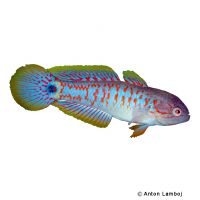Peacock Goby (Tateurndina ocellicauda)
| Peacock Goby Tateurndina ocellicauda | |
|---|---|
| Name | Peacock Goby |
| Name Lat. | Tateurndina ocellicauda |
| Family | Bully Sleepers |
| Family lat. | Eleotridae |
| Order | Gobies |
| Order lat. | Gobiiformes |
| Origin | New Guinea |
| Habitat | Streams, rivers, ponds |
| Diet | Carnivore |
| pH | 6.5-7.5 |
| Behavior | Peaceful |
| Keeping | Pair, group |
| Care Level | Moderate |
| Reproduction | Cave spawner |
| Breeding | Moderately difficult |
| Life Span | 3-5 years |
| Protection | No |
| Metric Units | |
| Size | 5-7 cm |
| Temperature | 22-26 °C |
| Hardness | 5-10 °dH |
| Aquarium | 60 l |
| US Units | |
| Size | 2"-2.8" |
| Temperature | 72-79 °F |
| Hardness | 89-178 ppm |
| Aquarium | 15 gal |
Distribution and habitat
The pastel gobies occur exclusively (endemic) in the lowlands of eastern Papua New Guinea. There they live in the densely vegetated shore areas of rainforest streams, small rivers and ponds, where they usually occur in loose shoals.
Maintenance
The aquarium should have dense planting, with plenty of hiding places (roots, stones, caves) and provide sufficient swimming space. A fine-grained substrate covered with some foliage (e.g. sea almond tree), shaded light (floating plants) and soft, slightly acidic water is ideal.
No ammonia, ammonium and nitrite should be detectable, the nitrate value should not exceed 100 mg/l. To ensure the water quality and oxygen content, a filter and heater adapted to the aquarium size is required, as well as lighting for the species-appropriate day-night rhythm of the animals.
Diet
They feed mainly on insect larvae, small crustaceans, shrimp and plankton. The food supply consists of live or frozen cyclops, daphnia, bosmids, artemia, mosquito larvae, etc. or a commercially available frozen special food mix. Dry food (granules, flakes) is also usually well accepted, but should not be the main component of the diet
Only as much should be fed as is eaten immediately (in a maximum of 10 minutes). A regular and varied diet promotes health and increases resistance.
Behaviour and compatibility
They are peaceful fish that should be kept in pairs or better in a group of 6-8 animals. Only during the spawning season they behave somewhat territorial within the species. They can be well socialized with other peaceful fish, such as rainbowfish and spikefish, but also with tetras, rasboras, armored catfish, etc
Basically, only compatible fish species with similar demands on water condition and water temperature should be socialized.
Sex dimorphism
The males are slightly larger and more intensely colored. The females have a bright yellow ventral zone and their anal fins have a black fringe.
Reproduction and breeding
When a pair is found, the female usually lays the eggs on the ceiling of the cave. There they are fertilized and guarded by the male. The larvae hatch after 24-48 hours and the male's brood care ends. After another 2-4 days the fry swim free and accept food.
Fry must be fed several times a day with special rearing food (liquid food, plankton, Artemia nauplii). Breeding is hardly possible in community tanks, where the fry are easy prey.
Important
Tateurndina ocellicauda is one of the smallest sleeper goby species, usually hiding among plants, roots and rocks during the day
They show their most beautiful coloration by feeding on live food.
The well-being of the fish should be checked regularly. The temperature should be checked daily, the pH, hardness and nitrate value at least every 14 days. Regular partial water changes are recommended, even if the contaminant level has not yet reached the upper limit. Sudden changes in water quality should be avoided. Newly introduced fish must be accustomed slowly to the water in the aquarium.
Further literature can be found in your pet store.
References
Text: Werner Winter; Image: Anton Lamboj
Source: BMELV (1998): Tierschutzgutachten - Haltung von Zierfischen (Süßwasser); BAENSCH & RIEHL (2004): Aquarien Atlas Bd. 2, Mergus Verlag; ENGELMANN (2005): Zootierhaltung - Tiere in menschlicher Obhut: Fische, Verlag Harri Deutsch
- Gemäß § 21 Abs. 5 Tierschutzgesetz idgF
